[This article, first posted in 2014, is the most frequently clicked out of our over 1000+ list. It is the last in the series from the book authored by Robert Schoen.
Earlier posts include:
- Must Read: Robert Schoen – 5 – Jews, Jesus, and Christianity/Judaism
- Must Read: Robert Schoen – 4 – Going to Church: The Jewish Roots of Christian Worship
- Must Read/Robert Shoen -3: A Range of Jewish Lifestyles, Beliefs, and Behaviors
- Must Read/Robert Schoen – 2: The Purpose for this Book
- MUST READ: What I Wish My Christian Friends Knew about JUDAISM by Robert Shoen
For the rest of the book chapters, you will have to get a copy for your library; that is why we do feature these MUST READ/MUST HAVE favorites in our library, to promote books you might otherwise not know about but could learn a lot from and would learn a lot more if you owned a copy. It’s downloadable as an ebook or kindle book from amazon.com, worth the price!—Admin1.]
——————————–
THE TORAH AND THE LAW
If you have ever been to a synagogue service or seen parts of a service on television or in a movie, you know that Jews read from a scroll. This scroll is the Torah. . In this day of sophisticated word processing and print technology, a highly trained scribe (sofer in Hebrew) still produces each scroll by hand. The sofer writes on parchment using a quill and special ink in the same way and to the same exacting standards as has been done for centuries.
Specifically, the Torah refers to the Five Books of Moses (the Pentateuch). Sometimes, however, people may use the word Torah in a general sense to refer to the entire Bible or to all the religious texts of the Jewish people.
The phrase “the Jewish Bible” refers to three distinct groups of Jewish writings.
- First is the Torah (the Pentateuch). These are the Five Books of Moses (Genesis, Exodus, Leviticus, Numbers, and Deuteronomy), recorded on the Torah scroll as described previously. Portions are read each week during synagogue services.
- The second section is known as the Prophets (in Hebrew Nevi’im) and includes the Books of Joshua, Judges, Samuel I and II, Kings I and II, Isaiah, Jeremiah, Ezekiel, and the twelve minor prophets, which count as one book (Hosea, Joel, Amos, Obadiah, Jonah, Micah, Nahum, Habakkuk, Zephaniah, Haggai, Zechariah, and Malachi).
- The third section is variously known as the Writings, the Hagiographa, or Ketuvim, a Hebrew word. This section includes the books of Psalms, Proverbs, Job, Song of Songs, Ruth, Lamentations, Ecclesiastes, Esther, Daniel, Ezra and Nehemiah (these count as one book), and Chronicles I and II.
Using the first letters of the Torah and the Hebrew words for the other two books (Nevi’im and Ketuvim), you arrive at the acronym TNK, which is pronounced “Tanakh”and is what Jewish people call the Bible (the Holy Scriptures) in Hebrew.
Many of the laws, passages, and directives in the Torah are not fully explained, are confusing, or may seem contradictory. Over the centuries, law based upon study and analysis of the Torah was passed down by word of mouth. This oral law, which provided explanations and amplifications of the written law, was finally organized and written down by the earliest rabbinic scholars in the first through third centuries CE and is known as the Mishnah (Hebrew for “recapitulation”).
The Mishnah deals with temple rituals, holiday observances, agricultural issues, and family life, but it also contains many proverbs and philosophical observations.
As scholars studied the Mishnah, they wrote down their commentaries and discussions about it.
These commentaries, called the Gemara (Aramaic for “study”), are interspersed into each paragraph or section of the Mishnah and give insight into historical, spiritual, ethical, and legal issues.
The combination of the Mishnah and the Gemara is called the Talmud. In case you’re not already confused, there are two versions of the Talmud:
- the Jerusalem (or Palestinian) Talmud and
- the Babylonian Talmud.
These days, when we refer to the Talmud, we refer to the Babylonian Talmud, which was completed about 500 CE. Talmudic study, while quite difficult, opens a world of spiritual wisdom, humor and anecdote, and rabbinical arguments and puzzles.
As a matter of fact, the Talmud is a storehouse of advice, recommending that we always begin a lecture with a funny story, that we should never have more than twenty-five students in a classroom, and that we should always give a person the benefit of the doubt. It also gives practical advice for otherwise arguable situations.
For example, when is Shabbat over? The answer is at the end of the day, when it is dark. How dark must it be for the day to be ended? The Talmud tells us that a person must be able to see three stars in the sky. But what if it is a rainy or overcast night? Consult the Talmud for the solution.
Throughout the ages, many illustrious and renowned Jewish scholars have contributed to the oral tradition, the Mishnah and the Talmud, and the Midrash, a collection of rabbinical questions and commentaries on the Bible (for example, “Why did God appear to Moses as a burning bush and not a tree?”).
Midrash is a Hebrew word meaning “investigation,” and passages in the Midrash often take the form of a story about whatever issue is being discussed or explained.
It is not unusual to refer to this group of rabbinical scholars as a source of information or authority when describing a particular law or practice in Judaism.
- Some people believe that the first rabbis were the Pharisees, a Jewish group that lived in the Holy Land at the time of Jesus. Their interpretation of the Torah was liberal for that day, and they introduced new ideas and concepts that were contrary to much of what was believed at the time.
- For the next thousand years, these scholars, teachers, and philosophers—collectively referred to as “the Rabbis” or “the Sages” —worked on the religious books and documents that form the core of Jewish religious writings.
The entire body of Jewish law is known as Halachah, and it is this law that guides observant Jews through life, indicating what should be done at any given time or in a given situation as well as what should not be done and what is not acceptable.
In other words, Halachah indicates patterns for behavior and for life in general. the root of the word Halachah means “to go” or “to walk,” and Halachah can be thought of as a person’s “path through life.”
Halachah, therefore, is a set of codes based on the Talmud that regulates family relationships, legal matters, education, diet, and personal and religious observances.
During the many years when Jews were self-governed in their own communities, these codes provided a legal system, which was a guide to what was acceptable and what was punishable as a crime. After Jews were no longer subject to the discipline of their own community, the law of the land in which they lived took precedence, but the Halachah lived on as a guide to personal behavior.
Modern Jews continue to seek spiritual guidance as well as practical advice from their rabbis and scholars, just as people of other religious groups seek help and advice from their pastors, ministers, and priests. While the Jewish tradition of law and commentaries on the Torah may not always be followed to the letter, these sources, spanning thousands of years and written and collected by the great minds of the ages, provide a wealth of guidance and wisdom from the past to be used in the present.
Issues covered by these writings vary in depth and importance, from marriage to divorce, from kosher kitchen practices to experimental scientific research, and from smoking in or near the synagogue to the introduction of female rabbis and cantors in congregations. Whatever the question or issue, Jewish tradition, wisdom, and scholarship can often help solve contemporary problems. While members of the different branches of Judaism follow these sources to different degrees (or not at all), they can be spiritual (as well as secular) guides if we wish them to be.
Prayers and Blessings
Any Jew can pray on his own. However, to say certain prayers or to have what is considered a full worship service, there must be at least ten adults present. This group is called a minyan. The requirements for being a member of a minyan vary among different congregations.
- Orthodox congregations require that the minyan comprise ten Jewish men over age thirteen.
- Most Conservative congregations include women in the ten-person minyan.
- Reform congregations generally do not require a minyan for group prayers.
It is considered somewhat of an honor to be the tenth person to join the group, since then the group can get to the business at hand. I remember occasions when someone had to go hustle up a tenth member, often calling someone on the phone or snatching a person from his office.
The number ten appears quite a few times in Judaism:
- ten commandments,
- ten plagues,
- Abraham’s ten tests of faith,
- the ten righteous in Sodom and Gomorrah, and so forth.
The congregation of “ten” comes from the Book of Numbers: ten of Moses’ spies, returning from the Land of Canaan, had distorted the truth, whereupon God proclaims, “How long shall this wicked congregation complain against me?” (Numbers 14:27).
In services where we read from the Torah, it is customary that when the Torah “stands” (is held or raised), the congregants stand; when the Torah sits (is placed on the reading lectern or returned to the ark), the congregants sit. Whenever the ark containing the Torah scrolls is open or when the scrolls are being carried, the congregants stand. There are some exceptions, but those are the general rules. Your physical abilities and health take precedence over these rules.
Traditional Orthodox Jews pray in the morning, in the afternoon, and again in the evening (although the afternoon and evening prayers are often said in succession). Depending on how observant they are, other Jews may pray once a day, once a month, once a year, or only when they feel the need to express happiness, grief, or some other emotion.
I was always under the impression that a person “faces east” when praying. In actuality, a person faces toward Jerusalem, specifically toward the site where the temple once stood. Thus, if you are in Turkey, you look at your compass and face south.
There are several prayers that are common to most services. The first (from Deuteronomy 6:4) is the Shema, an affirmation that announces, “Hear O Israel: The Lord is our God, the Lord is one.”
Liberal Jewish congregations now translate prayers so that they are gender-sensitive. Here is such a version of the same :
Hear, O Israel, the Eternal One is our God, the Eternal God alone! Blessed is God’s glorious majesty for ever and ever!
A second prayer basic to the service is the Amidah, generally recited silently while standing. In this prayer we ask God to give us peace and help us solve many of the personal problems and difficulties we all face.
The Aleinu is a prayer that looks to the future as one of hope and peace while reminding us that it is incumbent upon us to give praise to God.
The Kaddish prayer, extolling God’s majesty and kingdom, is recited several times during a service. Although having nothing to do with death, the Kaddish is traditionally recited while remembering the departed. As I get older, I hear (and recite) this prayer more and more as friends and relatives die.
As you might expect, there are blessings for everyday routines, such as waking, eating, traveling, and retiring for the day. Most common is the Grace before Meals, known as the Motzi or HaMatzi This prayer gives thanks for the “bread of the earth,” bread being symbolic of food in general:
We praise You, Eternal God, Sovereign of the universe,
for You cause bread to come forth from the Earth.
Another standard blessing is the blessing over wine, the Kiddush, giving thanks for “the fruit of the vine:
We praise You, Eternal God, Sovereign of the universe,
Creator of the fruit of the vine.
There is also a prayer of Grace after Meals as well as one that is recited before lighting the Shabbat candles.
After thousands of years, you can imagine that special prayers have developed to respond to special needs. Some may be considered bizarre and some unnecessary. Others may actually seem inappropriate or objectionable in this day and age (“Thank you, God, for not having created me a woman” [see “Women and Judaism”]).
Do all Jews recite all of these prayers? Hardly. As I’ve said before, it all depends on a person’s level of religious observance. Someone may use prayer time to offer up personal messages to God or to create his or her own individual devotions. However, the list of available prayers in Judaism is extensive.
Special prayers can be created for special needs. One special prayer thanks God for the creation of the rainbows. Or, remember the scene in Fiddler on the Roof when the townspeople ask the rabbi if there is a blessing for the czar? After a moment of reflection, the rabbi replies, “May the Lord bless and keep the czar . . . far away from us!”
Anyone who plays a reed instrument—clarinet, saxophone, oboe, or bassoon—knows the constant frustration of dealing with the fickle reeds. I once asked a rabbi if there could possibly be a blessing made over a saxophone reed or if this was a sacrilegious request. “Nonsense,” he replied, and offered me a prayer using the Hebrew word for reeds, zufim, which is the word used to describe the Reed Sea. I use the blessing now and am always happy to share it with my fellow musicians. Reeds still drive me crazy, but the prayer thanks God for creating and giving us the reed, the bread, the fruit of the earth, the rainbow, or whatever. The quality of the gift is not the primary issue.
Symbols—The Mezuzah and the Star of David
When you visit the homes of many Jews, you will find a small metal, wooden, glass, or ceramic case several inches in height called a mezuzah (literally, “doorpost”) fastened to the right doorpost of the front door. Inside the mezuzah is a tiny handwritten parchment scroll (called a klaf) containing two paragraphs from the Torah (Deuteronomy 6:4-9 and 11:13-21) as well as three Hebrew letters that spell one of the names used for God.
The Bible instructs us to “write them [God’s Words] on the doorposts of your house and on your gates” (Deuteronomy 6:9). As far back as two thousand years ago, Jews have chosen to follow this instruction using the mezuzah.
It is not uncommon for a person to kiss his or her fingertips and transfer the kiss to the mezuzah by touching it as he or she passes in and out of the home; others touch the mezuzah first and then kiss their fingers. Many Jews have only one mezuzah in their home, but some have them affixed to the doorway of each bedroom or living area in the house. Many people wear a small mezuzah on a chain around the neck as jewelry.
Like many customs, the fixing of the mezuzah is surrounded by tradition, mysticism, and a pinch of superstition. Some say the letters on the scroll make up an acronym that gives protection to the home. I know of a distinguished symphony conductor who delayed the move into his new house until the local rabbi could come to the home, certify that the scroll inside the mezuzah was proper, accurate, and legitimate, and conduct a formal ceremony at which the mezuzah was applied to the doorpost. Many people take these things very seriously.
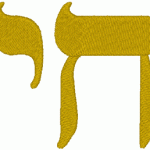 Another symbol often seen in pieces of jewelry is the chai, made up of two Hebrew letters. The word chai means “life,” just as the phrase (and song title), “L’Chaim!” (often used as a toast) means “to life.” In addition, the two letters making up the word chai have a numerical equivalent of eighteen, giving this number a special significance to Jews. Multiples of eighteen dollars are often given as gifts or donations.
Another symbol often seen in pieces of jewelry is the chai, made up of two Hebrew letters. The word chai means “life,” just as the phrase (and song title), “L’Chaim!” (often used as a toast) means “to life.” In addition, the two letters making up the word chai have a numerical equivalent of eighteen, giving this number a special significance to Jews. Multiples of eighteen dollars are often given as gifts or donations.
The six-pointed star, often called the Star of David, is commonly associated with Jews and Judaism. In Hebrew, it is known as the Magen David, which means “the shield of David.” Ironically, this symbol has been associated throughout the centuries not only with Jews, but with Muslims, Christians, and other groups. However, as it came to be used more and more in the design of synagogues built in Europe over three hundred years ago, it became identified as a Jewish symbol. It was so closely identified with Judaism that Nazis forced Jews to wear a yellow Star of David during the years of persecution and incarceration.
Now, the Star of David not only decorates jewelry, gifts, and other Judaica but also adorns the flag of the State of Israel. Jews around the world consider the Star of David a proud symbol of Judaism.


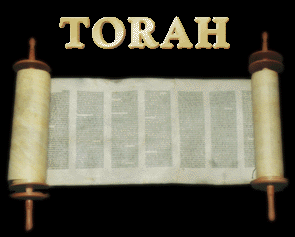
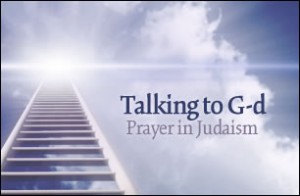
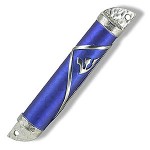
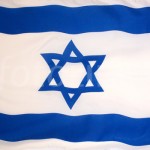
Reader Comments